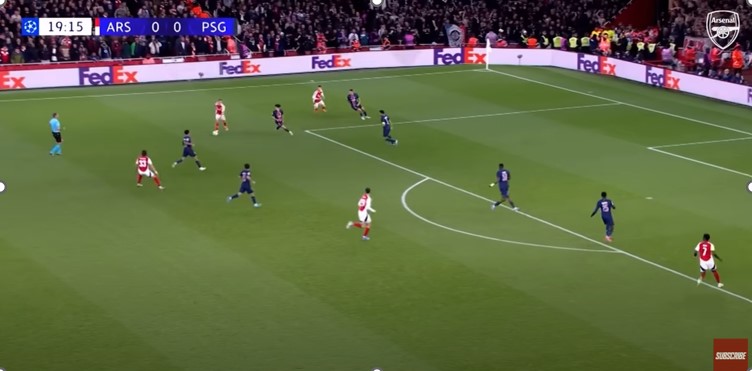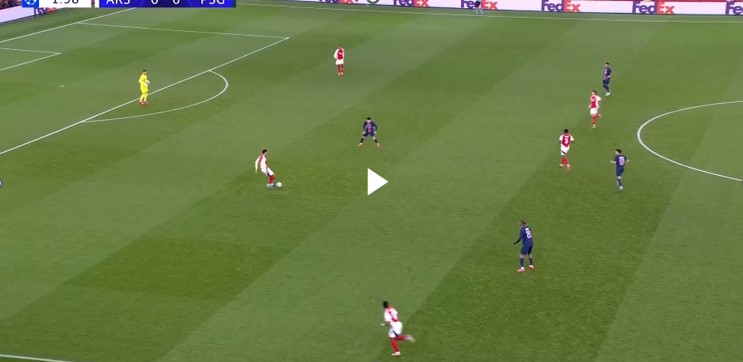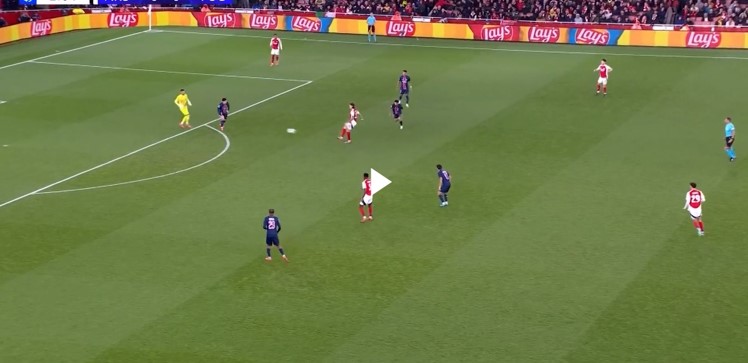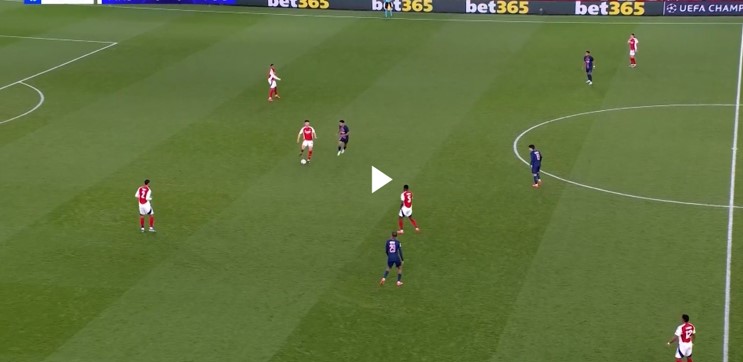Among Mikel Arteta’s great coaching triumphs during his spell at Arsenal is his ability to find solutions and problem solve. The absence of Martin Odegaard to injury posed a significant issue to Arteta and his team. For consecutive away matches at Spurs, Atalanta and Manchester City, the latter with ten men for close to an hour, pragmatism reigned. Arsenal gritted their teeth and relied on their off-ball shape and endeavour to take five points from those three games.
Last week, I posed the question as to how Arsenal would replace Odegaard during a block of three home games, where they would expect greater territory and more possession. In that article, I posited that Arsenal couldn’t repeat the pragmatic approach against Leicester, PSG and Southampton. With one of those games still to play, it is fair to say that I was probably off kilter.
Arsenal have largely played the same system with the same personnel, with Trossard and Havertz forming a sort of false 9 partnership where it is difficult to distinguish who is higher and who is lower at any one time. (And sometimes Havertz is stationed right out on the right wing). They have largely stuck with this sort of 4411 formation with Trossard and Havertz alternating, but with some adjustments around the edges.
The full-backs are turning up in ever stranger places as Arsenal look to build out in a box shape with the bottom left corner of that box, in particular, rotating regularly. But it is the partnership between Havertz and Trossard that propelled the Gunners to creating over four goals worth of XG against Leicester on Saturday and the pair combined to open the scoring against PSG.
Both are hybrid players, nobody really knows whether Havertz is a 9, a 10 or an 8. Nobody really knows whether Trossard is a centre-forward, a winger or a deeper lying forward. The truth, for both, is that they are all those things depending on the phase of play. The team is simultaneously strikerless and striker….full?
The combination between Trossard and Havertz for the opening goal against PSG is a really good example of this and calls to mind Alexis Sanchez’s header away at Leicester City back in September 2015, assisted with a chipped cross from the left half-space by Mesut Ozil.

As Trossard cuts in to cross here, Havertz is not in a centre-forward position, he is where you would expect an attacking central midfielder to be. The run he makes could easily have been made by a peak Aaron Ramsey.

In just two seconds, Havertz has seen the situation unfolding and made a run from deep into the area. The strength of Havertz and Trossard playing in such fluid positions is that opposing centre-halves often have nobody obvious to mark, as @ThatGooner sets out nicely below. Havertz is often playing the Odegaard role when the ball bears right but when it bears left, he is getting into the area to sniff out chances.
Flooding the 1st phase by operating without a nominal #9, and therefore excluding PSG's CBs, meant PSG's attackers were always caught between two men (often the AM & the DM). pic.twitter.com/5JQEZXH1UX
— PM (@ThatGooner) October 2, 2024
The injury to Odegaard could have been a significant trauma but the coach and the team adapted and found another way to play, banking on the partnership of a pair of players for whom fluidity is a pleasure not a chore. It adds another string to Arsenal’s bow and they have learned some new patterns and strengthened some partnerships. They still have Mikel Merino to add to this burgeoning mix as well.
Arsenal’s overall fluidity and difficulty to read for opponents has been aided by the addition of a pair of full-backs too in Jurrien Timber and Riccardo Calafiori. Both are essentially new additions even if Timber actually arrived last summer and I think my TL;DR assessment is that they represent upgrades on Takehiro Tomiyasu and Oleksandr Zinchenko, both of whom just cannot stay fit often enough to impact the team sufficiently.
The left-back slot felt a little unsatisfactory last season, Arsenal had a lot of strong 7/10 options but lacked a bona fide ‘left-sided Ben White’ quality. Tomiyasu, Zinchenko and, because of injuries to both (and Timber) Kiwior timeshared the role. But it always felt a little bit like a question mark on the teamsheet, one of the places your eye would drift to see who had been selected for a particular game.
Zinchenko helped to revolutionise the way that Arsenal played when he arrived two summers ago, drifting in-field as a left-sided six alongside Thomas Partey at the base of the Arsenal midfield. The problem was two-fold. One was the Ukrainian’s patchy fitness record, the other was that, after a while, the pattern of Zinchenko inverting became predictable and opponents adjusted.
Arsenal’s answer has been to change things up a little. For a start, Calafiori is clearly comfortable playing in more central areas but his real talent is driving the ball into space, which poses teams a different problem and gives the team something a little less static against deep block defences. The team is also rotating positions in build-up in the bottom left of that box shape.

As Arsenal build from the back early on in the PSG game, we can see Califiori in a parallel line to Thomas Partey in midfield, which is exactly where one might find Zinchenko in the same situation.

As Arsenal continue to pass around in their own third, we can see Califiori is still in that midfield position with Rice pushing out to the exterior of the team. It’s from this sequence that PSG are eventually attracted so high up the pitch that Raya nearly finds Martinelli in the PSG area with an outstanding long pass.
Clips of us repeatedly breaking down PSG's press last night.
Pretty fluid 2-2-2 centrally, always occupying the halfspace channels and pinning the deep flank spaces for (mostly) Trossard and Timber to exploit.pic.twitter.com/DqAcafBspU
— PM (@ThatGooner) October 2, 2024

Yet when Arsenal build here, later in the half, it is Rice who comes to the left six position to build out with Calafiori out on the exterior. There is much greater interchange in that zone now. Jurrien Timber has also added something significant to the mix from right-back. Firstly, his presence means that Ben White no longer has to play games holding his severed leg in one of his hands insisting, ‘aye, tis but a scratch.’
White has been one of Arsenal’s most consistent and reliable performers since he arrived in 2021 but even his position is no longer safe. Zinchenko and Jesus, much like Ramsdale last season, serve as pertinent reminders to the squad that, when competition is high, you can very quickly go from lead singer to roadie.
Against Leicester, Timber had four tackles (joint highest in the team), nine shot creating actions (second most), 53 carries (third most), 96 touches (third most), eight recoveries (second most) and wasn’t dispossessed all afternoon. He brings a punchiness and aggression to the role and the fact that the White, Odegaard and Saka triumvirate has had 66% of its constituent parts taken without generating any discussion or concern says a lot about the quality of Timber (and Havertz’s) displays.
If I had one reservation, it would be that I don’t know how Arsenal would adapt to a Havertz injury, it is simply impossible to imagine the team without him. The attempt to sign Benjamin Sesko during the summer suggests that Arteta feels like he needs, at minimum, a replicant of Havertz’s physical qualities in the forward line. But overall, it feels as though the coach and the team are adding layers to their approach and we have still seen precious little of Merino and Sterling yet.


